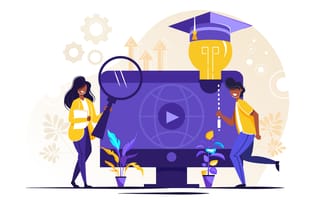Screencastify wasn’t meant to be an education tool. In fact, one of the first things CEO James Francis did when he joined the company in 2017 was to try and figure out why so many teachers were using it.
Screencastify launched in 2016 as a Google Chrome plug-in that simplified screen recordings. Video editing still required some technical know-how, so the idea was to create a freemium tool that streamlined the process to just a few clicks.
“There’s an amazing viral effect among teachers. They don’t just get happy and start using it more — they tell everyone they know.”
What they didn’t know was that the product had launched around the same time schools were moving to a blended-learning environment — a hybrid of tech-enabled and in-person instruction. The laptop of choice among school districts happened to be Google’s Chromebook, and teachers were already starting to experiment with video lessons. It turned out that Screencastify had aced a test it didn’t even know it was taking.
“It met all of those needs perfectly,” Francis said. “There’s an amazing viral effect among teachers. They don’t just get happy and start using it more — they tell everyone they know.”
As a result, one million users signed up within the first year, with many of them being teachers — its new target demographic.
Developing a sales strategy for edtech can be tricky, however. Unlike B2B sales, persistence and a hard, ROI-focused sales strategy doesn’t fly in education. In fact, pushing too hard on a sale with an educator isn’t just tone deaf — it can get your company blocked from a school or district.
In order to stand out and grow, Screencastify’s sales team learned that the best education sales strategy might be to let users speak for themselves.
Education Sales Strategies
- Keep the pitch short
- Help district leaders understand how their teachers are using your technology,
- Keep a focus on what students need
- Utilize teachers as product advocators

Keep the Pitch Short
When Nate Jones joined Screencastify as its first salesperson, he knew little about edtech. In his mind, teachers were still using the whiteboards and projectors from his days in school.
That quickly changed as he started learning about modern education. Last year, school districts used approximately 7,000 different tech tools ranging from e-learning programs to games, curriculum assessment platforms and beyond, according to EdWeek. And COVID-19 has only escalated the need for education technology.
As a result, vendors are flooding the inboxes of teachers and school administrators with pitches vying for attention.
“I’ve been on many screen shares with school district directors of technology,” Jones said. “Their inboxes will have like 127 emails just from that morning, and they’re all the same sales pitch. They’re just getting inundated.”
Screencastify has a mixed inbound and outbound sales strategy. Its product offerings include a free version that allows teachers to record five-minute videos, a paid premium plan and a custom school district plan in which all teachers are reimbursed.
“Their inboxes will have like 127 emails just from that morning, and they’re all the same sales pitch. They’re just getting inundated.”
In their effort not to add to the noise, Jones and Screencastify’s sales team found that the most effective pitch is not really a pitch at all. After testing a few email variations — including one filled with emoji — Jones landed on a short, three-line message sent to district and school directors of technology.
The message includes data on how many teachers in the district are using Screencastify and an offer to share usage insights. The purpose is to help district leaders understand how their teachers are using the technology, regardless of whether or not they want to buy it, Francis said.
“For us, value is not one sentence about what life could be like with this product,” Francis said. “When you read an email from us, it’s like, ‘I can leave this call from them with a lot more information that’s good for me and never talk to them again.’”
Focus on What Students Need
In edtech, it can be difficult to predict what a school or district needs or even what impact the tool can have on its students before a call.
That’s because each school district has a wildly different approach to technology. Some districts purchase the tools for every school in its territory, while others allow each individual school to manage its tech. Districts are also in different phases of technology implementation. Some may not even have laptops available in the classroom yet, and thus, no need for a video solution.
“We’ll say, ‘You guys have made 10,000 videos this year, help us understand how that grew.’”
As a result, Screencastify’s sales team doesn’t have a playbook. Often, a sales rep will share usage data and let the school district explain what they need.
“We’ll say, ‘You guys have made 10,000 videos this year, help us understand how that grew.’ Then we’ll dive into: ‘Where do you value video? What part of the education process are you in? Are we even a fit for you?’” Jones said.
The rest of the conversation is based on listening and doing what’s best for students, Francis said. Educators will be quick to end the call if they sense a salesperson is worrying more about the sale than the students.
“If it’s clear that the free product is what’s best for their students and you agree with them based on what they’ve told you, then you have their trust forever,” Francis said.

Teachers Can Become Great Advocates for Your Product
Building that trust with teachers is especially important. A recent survey found that teachers trust other teachers and educators most when it comes to finding effective edtech tools, according to EdSurge.
An educator who decides to stick with the free version might recommend Screencastify to a colleague or administrator with different needs.
As Francis looks to grow his sales team, his goal is to bring on salespeople who either have classroom experience or have the ability to empathize with the needs of educators.
Screencastify may not have planned to be an education tool, but now with 12 million members, according to its website, that’s what it has become. And its sales team does whatever it can to support those users.
“We are doing ourselves a disservice if we’re bringing the energy selling Screencastify and not figuring out a way for our buyers to understand that among their own teachers,” Francis said. “It’s so much more productive, it’s so much more confident and it’s so much more welcome.”




